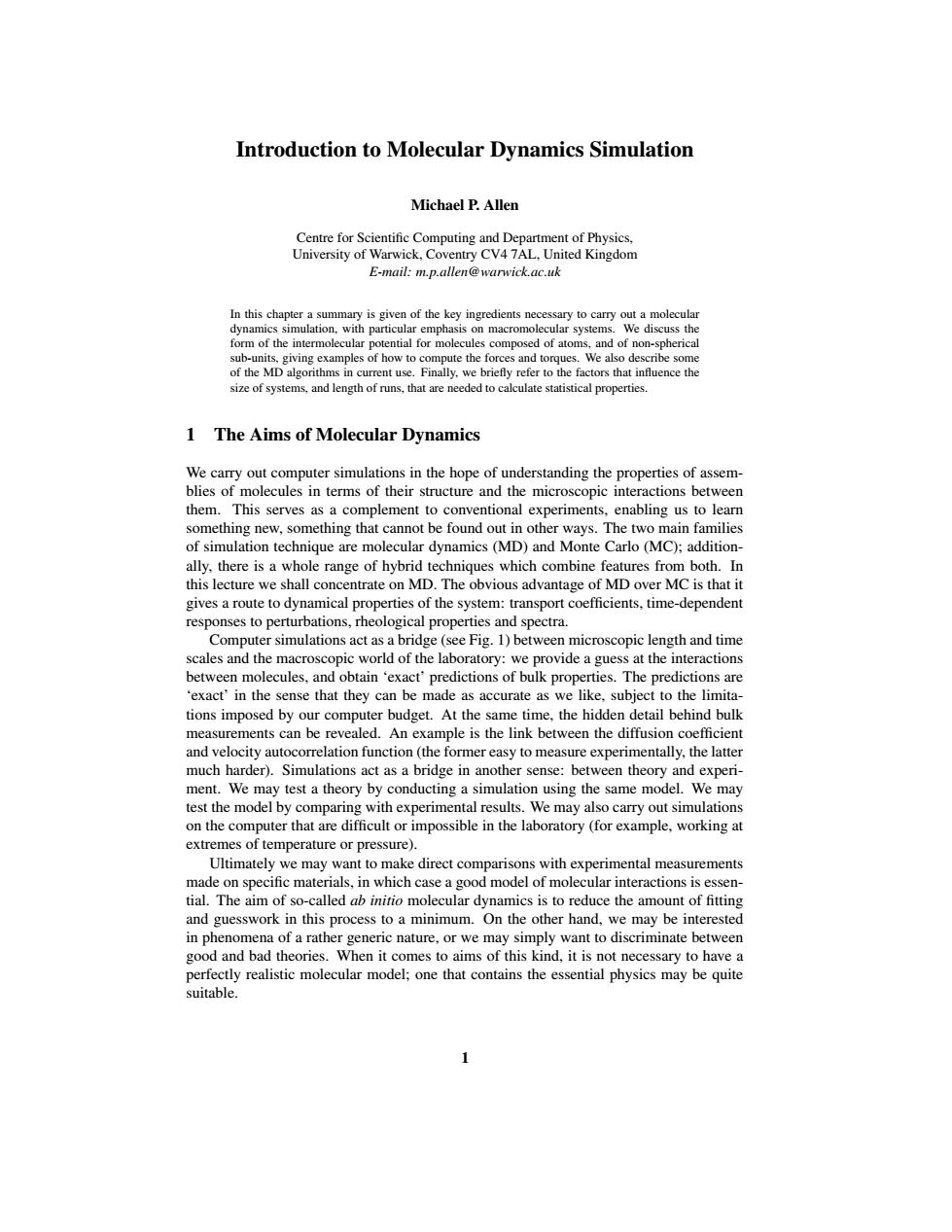正在加载图片...

Introduction to Molecular Dynamics Simulation Michael P.Allen Centre for Scientific Computing and Department of Physics, University of Warwick,Coventry CV4 7AL,United Kingdom E-mail:m.p.allen@warwick.ac.uk In this chapter a summary is given of the key ingredients necessary to carry out a molecular dynamics simulation,with particular emphasis on macromolecular systems.We discuss the form of the intermolecular potential for molecules composed of atoms,and of non-spherical sub-units,giving examples of how to compute the forces and torques.We also describe some of the MD algorithms in current use.Finally.we briefly refer to the factors that influence the size of systems,and length of runs,that are needed to calculate statistical properties. 1 The Aims of Molecular Dynamics We carry out computer simulations in the hope of understanding the properties of assem- blies of molecules in terms of their structure and the microscopic interactions between them.This serves as a complement to conventional experiments,enabling us to learn something new,something that cannot be found out in other ways.The two main families of simulation technique are molecular dynamics(MD)and Monte Carlo(MC);addition- ally,there is a whole range of hybrid techniques which combine features from both.In this lecture we shall concentrate on MD.The obvious advantage of MD over MC is that it gives a route to dynamical properties of the system:transport coefficients,time-dependent responses to perturbations,rheological properties and spectra. Computer simulations act as a bridge(see Fig.1)between microscopic length and time scales and the macroscopic world of the laboratory:we provide a guess at the interactions between molecules,and obtain 'exact'predictions of bulk properties.The predictions are 'exact'in the sense that they can be made as accurate as we like,subject to the limita- tions imposed by our computer budget.At the same time,the hidden detail behind bulk measurements can be revealed.An example is the link between the diffusion coefficient and velocity autocorrelation function(the former easy to measure experimentally,the latter much harder).Simulations act as a bridge in another sense:between theory and experi- ment.We may test a theory by conducting a simulation using the same model.We may test the model by comparing with experimental results.We may also carry out simulations on the computer that are difficult or impossible in the laboratory (for example,working at extremes of temperature or pressure). Ultimately we may want to make direct comparisons with experimental measurements made on specific materials,in which case a good model of molecular interactions is essen- tial.The aim of so-called ab initio molecular dynamics is to reduce the amount of fitting and guesswork in this process to a minimum.On the other hand,we may be interested in phenomena of a rather generic nature,or we may simply want to discriminate between good and bad theories.When it comes to aims of this kind,it is not necessary to have a perfectly realistic molecular model;one that contains the essential physics may be quite suitable.Introduction to Molecular Dynamics Simulation Michael P. Allen Centre for Scientific Computing and Department of Physics, University of Warwick, Coventry CV4 7AL, United Kingdom E-mail: m.p.allen@warwick.ac.uk In this chapter a summary is given of the key ingredients necessary to carry out a molecular dynamics simulation, with particular emphasis on macromolecular systems. We discuss the form of the intermolecular potential for molecules composed of atoms, and of non-spherical sub-units, giving examples of how to compute the forces and torques. We also describe some of the MD algorithms in current use. Finally, we briefly refer to the factors that influence the size of systems, and length of runs, that are needed to calculate statistical properties. 1 The Aims of Molecular Dynamics We carry out computer simulations in the hope of understanding the properties of assemblies of molecules in terms of their structure and the microscopic interactions between them. This serves as a complement to conventional experiments, enabling us to learn something new, something that cannot be found out in other ways. The two main families of simulation technique are molecular dynamics (MD) and Monte Carlo (MC); additionally, there is a whole range of hybrid techniques which combine features from both. In this lecture we shall concentrate on MD. The obvious advantage of MD over MC is that it gives a route to dynamical properties of the system: transport coefficients, time-dependent responses to perturbations, rheological properties and spectra. Computer simulations act as a bridge (see Fig. 1) between microscopic length and time scales and the macroscopic world of the laboratory: we provide a guess at the interactions between molecules, and obtain ‘exact’ predictions of bulk properties. The predictions are ‘exact’ in the sense that they can be made as accurate as we like, subject to the limitations imposed by our computer budget. At the same time, the hidden detail behind bulk measurements can be revealed. An example is the link between the diffusion coefficient and velocity autocorrelation function (the former easy to measure experimentally, the latter much harder). Simulations act as a bridge in another sense: between theory and experiment. We may test a theory by conducting a simulation using the same model. We may test the model by comparing with experimental results. We may also carry out simulations on the computer that are difficult or impossible in the laboratory (for example, working at extremes of temperature or pressure). Ultimately we may want to make direct comparisons with experimental measurements made on specific materials, in which case a good model of molecular interactions is essential. The aim of so-called ab initio molecular dynamics is to reduce the amount of fitting and guesswork in this process to a minimum. On the other hand, we may be interested in phenomena of a rather generic nature, or we may simply want to discriminate between good and bad theories. When it comes to aims of this kind, it is not necessary to have a perfectly realistic molecular model; one that contains the essential physics may be quite suitable. 1